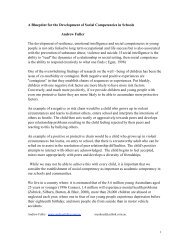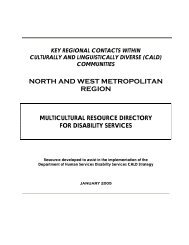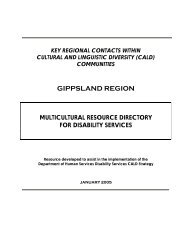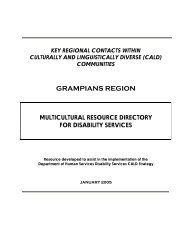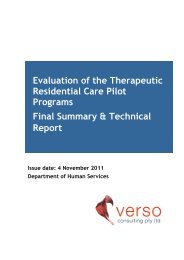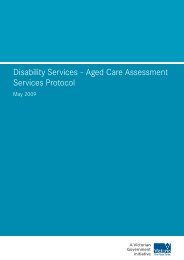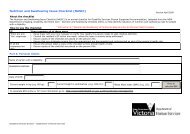Positive Behaviour Support - Department of Human Services - Vic ...
Positive Behaviour Support - Department of Human Services - Vic ...
Positive Behaviour Support - Department of Human Services - Vic ...
You also want an ePaper? Increase the reach of your titles
YUMPU automatically turns print PDFs into web optimized ePapers that Google loves.
8 <strong>Positive</strong> behaviour support: Getting it right from the start - Facilitators reference manual<br />
PowerPoint 11 *<br />
PowerPoint 12 *<br />
The following model is a brief guide to staff to remind staff <strong>of</strong> key things to think about when<br />
planning positive behaviour support for a person showing behaviours <strong>of</strong> concern.<br />
Proactive strategies<br />
What to do to prevent the behaviour<br />
Change the<br />
environment<br />
Gathering relevant<br />
personal background<br />
information that leads to:<br />
• increased opportunities<br />
for access to a variety<br />
<strong>of</strong> activities<br />
• ‘balanced lifestyle’<br />
• predictable<br />
environment<br />
• consistent routines<br />
• improved interactions<br />
and realistic<br />
expectations<br />
Teaching skills<br />
<strong>Positive</strong> Intervention Framework 1<br />
General skills<br />
development<br />
(e.g. teaching person to<br />
do more things for self)<br />
Useful communication<br />
strategies that promote<br />
effective communication<br />
(e.g. teaching the person<br />
to sign when seeking<br />
social interaction)<br />
Coping skills<br />
(e.g. teach the person<br />
what to do when<br />
feeling angry)<br />
Short-term change<br />
strategies for rapid<br />
change to behaviour<br />
To support the learning<br />
<strong>of</strong> new skills such as:<br />
• reinforcing specific<br />
behaviour<br />
• avoiding things you<br />
know upsets the<br />
person<br />
• strategies to increase<br />
engagement<br />
Immediate response<br />
strategies<br />
What might help when<br />
the behaviours occur;<br />
beginning with least<br />
restrictive strategies?<br />
Redirection<br />
(e.g. ‘distract’ the<br />
person by <strong>of</strong>fering<br />
another activity)<br />
Talk to the person<br />
and find out what the<br />
problem is<br />
Work out what the<br />
person’s behaviour is<br />
trying to communicate<br />
Responding to early<br />
signs <strong>of</strong> the behaviour<br />
Responding to serious<br />
episodes <strong>of</strong> the<br />
behaviour<br />
In groups develop a brief snap shot <strong>of</strong> a person you work with. This snap shot should<br />
identify major strengths and interests <strong>of</strong> the person as well as clear examples <strong>of</strong> any <strong>of</strong> the<br />
behaviours <strong>of</strong> concerns that are displayed.<br />
This snap shot will be further developed and expanded over the course <strong>of</strong> the next few<br />
sessions.<br />
This snap shot should cover all key quality <strong>of</strong> life areas and be written focussing on the<br />
strengths and interests <strong>of</strong> the person concerned.<br />
1. The Multi element model, La Vigna, Willis and Donnellan (Institute for Applied <strong>Behaviour</strong> Analysis) 1996.



